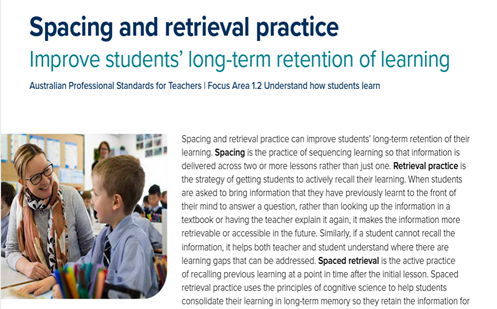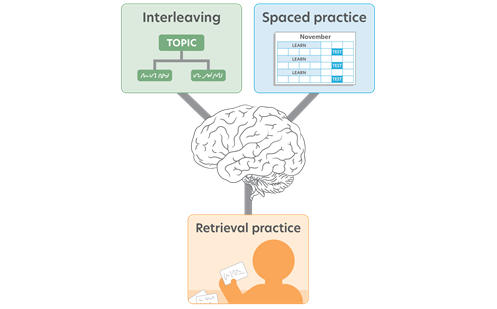Spaced, interleaved and retrieval practice
Overview
These are three strategies that can be used to increase student retention and recall of their learning. They are based on the neuroscience of how the brain takes in, retains and retrieves information. These techniques can be used for any subject.
Spaced practice is when students are tested at spaced intervals on the material they have been learning. First every day, then after two or three days, then with longer intervals. The act of retrieving the information forms part of the learning process. The assessment can be in the form of low stakes or no stakes spot tests with only one or two questions. Once a topic is ‘finished’ the assessment continues over time so that the learning is not forgotten.
Interleaving is when a large topic is split into smaller chunks. Each chunk is interleaved (mixed) with small chunks of other topics. This is sometimes called spiralling as each topic is returned to and built on. A spiralled curriculum can be constructed for a year level or for a whole school.
Retrieval practice is a technique that students can learn to help them revise and retain what they have learnt. Students should be encouraged that studying little and often is better than cramming. By doing a few minutes of retrieval practice a day they should not need to cram for hours before a major test or exam. Retrieval practice can be achieved through techniques such as the use of flashcards, rewriting of definitions or equations or writing down what they remember about a topic.
The teacher:
- models and teaches the techniques
- teaches students the neuroscience of learning
- plans an interleaved curriculum (for the year or longer)
- continually assesses students on past topics
- uses low or no stakes quizzes to help students retrieve and retain their learning.
The students:
- know and practise the techniques for spaced practice and retrieval practice
- do a few minutes of retrieval practice every day
- understand the neuroscience of learning.
Example of the strategy in action

Spacing and retrieval practice
This article gives more detail on the research behind these techniques.
